I’ve explored the top wireless subwoofer systems of 2025 that deliver deep, powerful bass with minimal setup. From sleek soundbars with Dolby Atmos support to high-end 7.1 channel surround systems, these options offer immersive sound and flexible placement options. Whether you prefer wired or wireless setups, many models emphasize easy installation, rich bass, and versatile connectivity. If you’re after the best options to elevate your home theater experience, you’ll find plenty of great choices to discover next.
Key Takeaways
- Look for systems with high power output (up to 330W peak) and advanced bass drivers like BassMX for deep, impactful bass.
- Prioritize models supporting Dolby Atmos and DTS:X for immersive, multidimensional sound experiences.
- Choose wireless options with stable Bluetooth 5.4 or Wi-Fi connectivity for reliable, cable-free deep bass performance.
- Consider systems with customizable EQ settings and bass enhancement features to optimize low-frequency response.
- Opt for versatile setups offering both wired and wireless subwoofers for flexible placement and powerful low-end performance.
VIZIO 5.1 Soundbar with Wireless Subwoofer and Dolby Atmos

If you’re looking for an immersive home theater experience without the hassle of messy wires, the VIZIO 5.1 Soundbar with Wireless Subwoofer and Dolby Atmos is an excellent choice. It delivers powerful 96dB sound with three full-range speakers, two surround speakers, and a wireless subwoofer for true 3D audio. The sleek black design includes QuickFit™ mounting for easy setup with select VIZIO TVs, ensuring a clean look. Connect via HDMI eARC for seamless TV control, and use Bluetooth for streaming music. Setup is simple, and users praise its sound quality, making it a versatile, high-impact system for medium-large rooms.
Best For: home entertainment enthusiasts seeking immersive surround sound with easy setup and seamless TV integration in medium-large rooms.
Pros:
- Delivers powerful 96dB sound with immersive Dolby Atmos and DTS:X support
- Easy to set up with QuickFit™ mounting and plug-and-play design
- Wireless subwoofer and surround speakers reduce clutter and enhance surround sound experience
Cons:
- Remote control sold separately, which may be inconvenient for quick adjustments
- App control can be difficult to link or use, especially in certain regions like Canada
- Not waterproof or water-resistant, requiring careful placement and cable management
MZEIBO Bluetooth Sound Bar with Subwoofer

The MZEIBO Bluetooth Sound Bar with Subwoofer stands out as an excellent choice for those seeking versatile home audio, thanks to its detachable design and multiple connectivity options. With a 120W power output, it delivers deep, immersive bass and clear sound for movies, music, and gaming. Its flexible setup allows you to use it as a single bar or split into two towers, fitting various space and style needs. It supports ARC, Optical, AUX, Bluetooth 5.0, and HDMI-ARC, ensuring compatibility with most devices. Easy to install and operate, it’s perfect for small to medium rooms, offering great value and sound quality.
Best For: those seeking a versatile, easy-to-setup home audio solution with deep bass and multiple connectivity options for small to medium-sized rooms.
Pros:
- Detachable design allows flexible use as a soundbar or two tower speakers for surround sound.
- Supports multiple input options including ARC, Optical, AUX, Bluetooth 5.0, and HDMI-ARC for broad device compatibility.
- Powerful 120W output with wired subwoofer delivers clear, immersive sound with deep bass.
Cons:
- Subwoofer is wired, which may limit placement flexibility.
- Remote control lacks backlight and may feel flimsy for some users.
- Bass drops off below 60Hz, lacking rumble for very deep bass effects.
ULTIMEA 5.1CH Surround Sound Bar with Subwoofer

The ULTIMEA 5.1CH Surround Sound Bar with Subwoofer stands out as the ideal choice for home theater enthusiasts seeking effortless setup and immersive audio. It features a simplified 5.1-channel Dolby Atmos setup with five built-in speakers, including side-firing drivers, creating wide surround sound without rear speakers. The system uses precision DSP for less than 0.5 ms latency, ensuring smooth, theater-like audio. Setup takes under a minute, and HDMI eARC supports lossless Dolby Atmos with richer effects. With 300W power, a wired subwoofer, and customizable sound profiles via the Ultimea app, it delivers deep bass and clear dialogue effortlessly.
Best For: home theater enthusiasts who want an easy-to-set-up, immersive surround sound experience with customizable audio profiles.
Pros:
- Simplified 5.1-channel Dolby Atmos setup with built-in side-firing speakers for wide surround sound without rear speakers
- Low latency DSP ensures smooth, theater-like audio with less than 0.5 ms delay
- Customizable sound profiles and deep bass via the Ultimea app for tailored listening experiences
Cons:
- Requires compatible smart TV or devices for full functionality of HDMI eARC and CEC features
- May be limited in rear surround options compared to traditional multi-speaker systems
- The wired subwoofer setup might be less flexible for room placement
Sound Bar for Smart TV 2.1CH with Subwoofer and Bluetooth

Looking to upgrade your home entertainment setup with a versatile sound solution? The Sound Bar for Smart TV 2.1CH with Subwoofer and Bluetooth offers rich, immersive audio in a compact design that fits seamlessly into any space. Its detachable feature lets you split it into two towers for wider stereo or keep it unified under your TV. With Bluetooth 5.4, HD ARC, AUX, Optical, and USB ports, connecting your devices is effortless. The 190W system with a 12L subwoofer delivers deep, powerful bass, while adjustable sound modes customize your experience. Setup is quick, and all cables are included, making it perfect for movies, gaming, or music.
Best For: home entertainment enthusiasts seeking a versatile, easy-to-setup sound system for TV, gaming, or music.
Pros:
- Rich, immersive 2.1 channel audio with deep bass from the 12L subwoofer.
- Detachable design allows flexible setup as two towers or a unified unit.
- Multiple connectivity options including Bluetooth 5.4, ARC, AUX, Optical, and USB for broad device compatibility.
Cons:
- Does not support Dolby Audio, which may limit compatibility with certain content.
- Wired connections between soundbar segments and subwoofer may restrict placement options.
- Slightly over 2 feet tall, which might be large for very compact spaces.
ULTIMEA 7.1ch Virtual Surround Sound Bar with Subwoofer
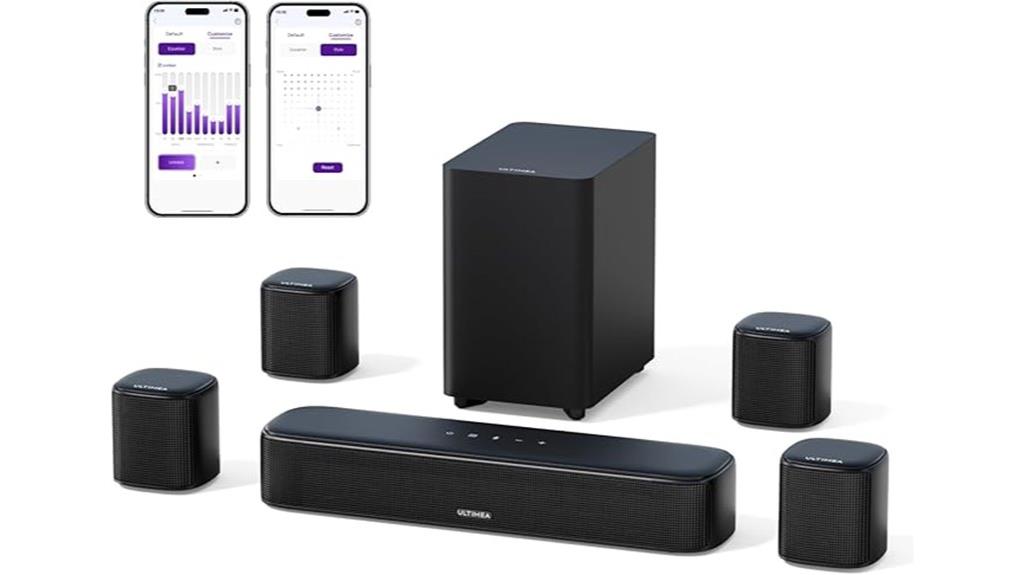
If you’re seeking an immersive home theater experience with flexible setup options, the Ultimea Aura A40 7.1ch virtual surround sound bar is an excellent choice. It features a compact main soundbar, four wired surround speakers, and a 4-inch wired subwoofer, delivering a total peak power of 330W. Its SurroundX technology creates precise, expansive virtual surround sound, while BassMX provides punchy bass. The system is easy to install with included wall mounts and supports both tabletop and wall mounting. Compatible with TVs, gaming consoles, and smartphones, it offers extensive customization via the app, including preset EQ modes and adjustable surround levels for a tailored, immersive audio experience.
Best For: those seeking an immersive, customizable home theater audio solution with flexible setup options for various entertainment devices.
Pros:
- Delivers immersive 7.1 virtual surround sound with SurroundX technology for a spacious audio experience.
- Highly customizable via the Ultimea Smart App with multiple EQ modes and adjustable surround levels.
- Easy to install and supports both tabletop and wall mounting, including included wall mounts and brackets.
Cons:
- Lacks Dolby Atmos support for more advanced spatial audio effects.
- Top-end sound performance could be more refined, with some users noting room for improvement.
- Wired surround speakers and subwoofer may limit cable management options in certain setups.
ULTIMEA 5.1ch Sound Bar with Dolby Atmos and Surround Sound System

For anyone seeking an immersive home theater experience without clutter, the Ultimea Aura A50 Pro stands out as an excellent choice. This sleek 5.1 channel sound system features Dolby Atmos for 3D surround sound, making movies, games, and music come alive. Its wireless surround speakers reduce cable clutter, while the compact wired subwoofer delivers deep bass despite its small size. Setup is simple with multiple connection options, including HDMI eARC, Bluetooth, and Optical. The customizable EQ settings via the Ultimea app let me fine-tune sound to my preferences. Overall, it offers fantastic audio performance and convenience at an incredible value, transforming any room into a home theater.
Best For: those seeking an affordable, easy-to-setup home theater system with immersive Dolby Atmos surround sound and customizable audio options.
Pros:
- Easy setup with multiple connection options including HDMI eARC, Bluetooth, and Optical
- Wireless surround speakers reduce cable clutter for a clean look
- Powerful deep bass and clear dialogue with Dolby Atmos support and customizable EQ via the app
Cons:
- Not waterproof, so it’s unsuitable for outdoor use or humid environments
- Performance may be limited in very large rooms over 215 square feet
- Slightly heavier and larger than some compact soundbars, requiring adequate space for placement
Sony HT-S40R 5.1ch Home Theater Soundbar System,black
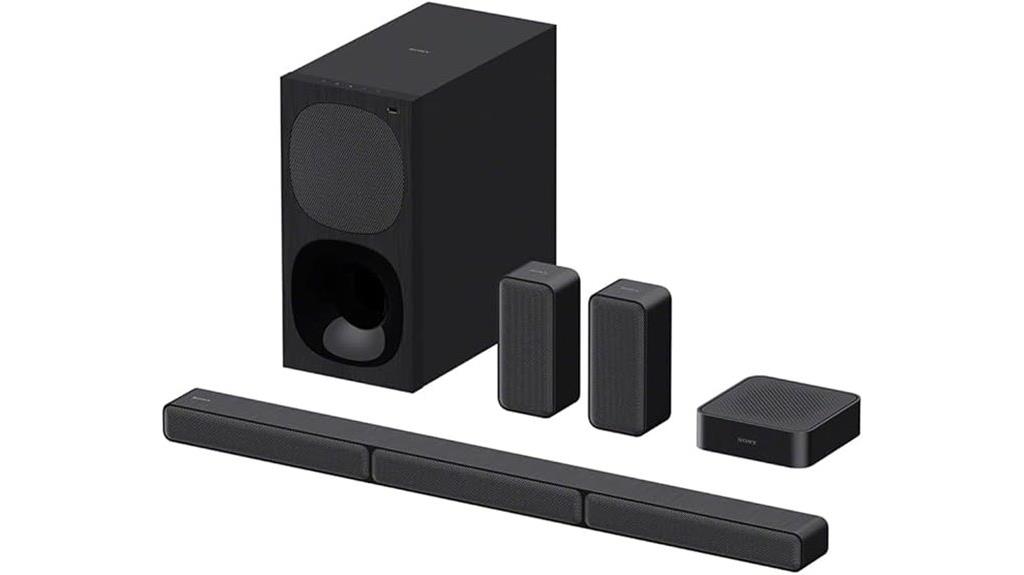
The Sony HT-S40R 5.1ch Home Theater Soundbar System stands out for those seeking an immersive audio experience without complicated setup. It delivers 600W of power through a soundbar, wireless subwoofer, and rear speakers, creating a true surround sound environment. Features like bass boost, dialogue enhancement, and multiple sound modes—cinema, music, voice, night—enhance versatility. Setup is quick and simple with color-coded connections, taking about 10 minutes. Compatible with HDMI ARC, Bluetooth, and more, it easily connects to various devices. Ideal for medium-sized rooms, it offers crisp highs, deep lows, and effective surround sound, making it a solid choice for home entertainment.
Best For: those seeking an easy-to-set-up, immersive home theater system for medium-sized rooms with versatile sound options.
Pros:
- Simple setup with color-coded connections, taking around 10 minutes
- Powerful 600W audio output with multiple sound modes and adjustable bass
- Compatible with various devices via HDMI, Bluetooth, USB, and optical connections
Cons:
- Some users report weak surround sound and connection issues with rear speakers
- Occasional sound inconsistencies like popping noises or difficulty hearing rear speakers
- Customer support and warranty services have received mixed reviews, leading to dissatisfaction for some buyers
ULTIMEA 5.1 Virtual Surround Sound Bar with Subwoofer

The ULTIMEA 5.1 Virtual Surround Sound Bar with Subwoofer stands out as an excellent choice for anyone seeking immersive audio without the complexity of traditional surround sound systems. It delivers rich, clear highs and punchy lows, perfect for movies, gaming, and parties. Its SurroundX Technology creates a virtual 5.1 experience, simulating hall-like sound. The system includes a sleek soundbar, a powerful 5.25-inch subwoofer, and wired rear speakers for flexible placement. With multiple preset EQ modes and manual tuning, I can customize sound to my preference. Easy to set up and compatible with various devices, this system offers great value and impressive performance.
Best For: those seeking an affordable, easy-to-setup virtual surround sound system for medium-sized rooms to enhance movies, gaming, and entertainment experiences.
Pros:
- Delivers immersive audio with rich highs and punchy lows using SurroundX Technology
- Easy plug-and-play setup with versatile connectivity options including HDMI ARC, Bluetooth, optical, and RCA
- Compact, sleek design with flexible placement of wired rear speakers and wireless soundbar
Cons:
- Does not produce true 5.1 surround sound, offering virtual surround effects instead
- Surround speakers may be quieter even when turned up fully, affecting balanced sound
- Some remote controls may have basic functionality, limiting advanced customization
ULTIMEA 7.1ch Soundbar with Wireless Subwoofer
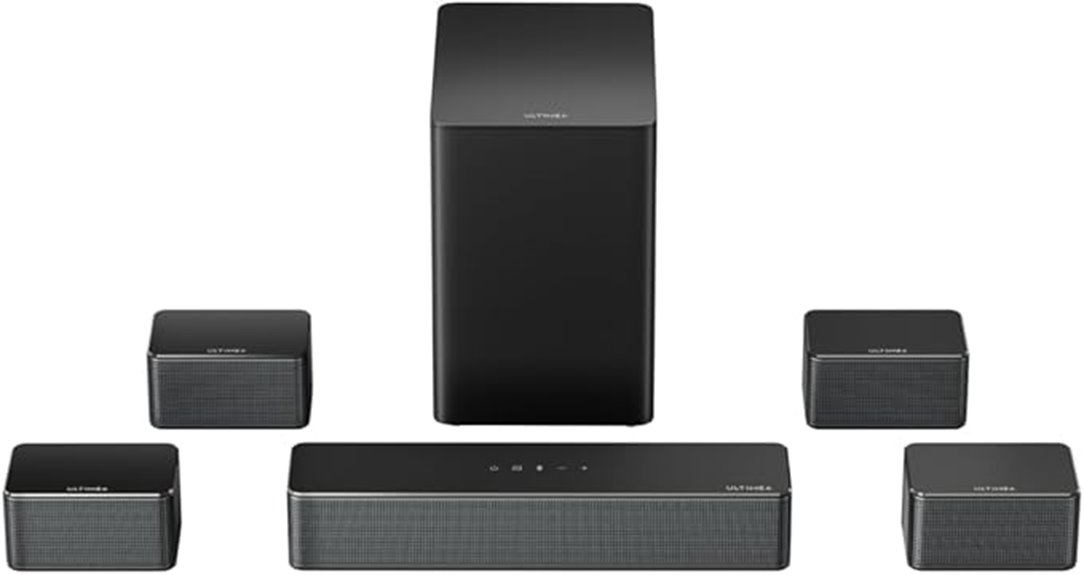
If you’re seeking a versatile home theater upgrade that combines powerful sound with easy setup, the ULTIMEA 7.1ch Soundbar with Wireless Subwoofer stands out. It delivers immersive 7.1-channel virtual surround sound, enhanced by a 6.5-inch wireless subwoofer and four wired surround speakers. With multiple sound modes, EQ adjustments, and a peak power of 410W, it fills rooms with rich bass and clear dialogue. Control via the dedicated app makes customization simple, and the system supports Bluetooth and HDMI ARC for seamless connections. Its compact design and straightforward setup—often under 10 minutes—make it an excellent choice for upgrading your home entertainment.
Best For: those seeking an affordable, easy-to-setup home theater system with immersive 7.1-channel sound and customizable audio options.
Pros:
- Easy and quick setup, often completed in under 10 minutes
- Powerful 410W peak power with rich bass and clear dialogue
- Versatile connectivity options including Bluetooth and HDMI ARC for seamless device integration
Cons:
- Wired surround speakers may be unsightly if cables are visible
- Lacks Dolby Atmos support, which may limit some immersive audio experiences
- Some users report hollow sound at very high volumes despite strong bass
Polk Audio Signa S2 Sound Bar with Wireless Subwoofer

For anyone seeking an affordable yet powerful home theater upgrade, the Polk Audio Signa S2 Sound Bar with Wireless Subwoofer stands out as an excellent choice. Its ultra-slim, low-profile design easily fits in most spaces and won’t block your TV’s IR sensor. With a wireless subwoofer featuring a 5.25-inch driver, it delivers rich sound and deep bass impact. Equipped with five full-range drivers and Dolby Digital decoding, it offers immersive surround sound and enhanced dialogue clarity via Polk’s VoiceAdjust technology. Setup is quick using HDMI or optical, and Bluetooth streaming adds convenience. Overall, it provides impressive sound quality at a budget-friendly price, making it a smart upgrade for many homes.
Best For: budget-conscious consumers seeking an easy-to-set-up, immersive home theater sound system with deep bass and clear dialogue.
Pros:
- Ultra-slim, low-profile design that fits in most spaces without blocking TV sensors
- Powerful sound with deep bass from the wireless 5.25-inch subwoofer and Dolby Digital decoding
- Quick and straightforward setup via HDMI ARC or optical, with Bluetooth streaming for added convenience
Cons:
- Limited EQ customization options and no detailed sound adjustments
- Slight audio delay (1-2 seconds) when activating videos on platforms like YouTube
- Lacks advanced features like Alexa compatibility and detailed volume level displays
ULTIMEA 5.1.2ch Sound Bar with Dolby Atmos

The ULTIMEA 5.1.2ch Sound Bar with Dolby Atmos stands out as an ideal choice for home theater enthusiasts seeking immersive, multidimensional audio. Its advanced system features up-firing speakers with aerospace-grade neodymium magnets and large voice coils, delivering precise height effects. SurroundX technology creates a true 360° sound field by combining rear surround speakers and dual Atmos drivers, while Dolby Atmos support via HDMI eARC guarantees lossless, high-quality audio. Easy to set up with Bluetooth 5.4, app control, and automatic component pairing, it offers rich, punchy bass from its wired subwoofer and impressive surround effects, elevating any home theater experience.
Best For: home theater enthusiasts seeking immersive, multidimensional audio with easy setup and high-quality Dolby Atmos experience.
Pros:
- Advanced Dolby Atmos support with true 360° sound field and height effects
- Easy plug-and-play setup with automatic component pairing and app control
- Rich, punchy bass from wired subwoofer and clear surround effects
Cons:
- Rear surround speakers may weaken at greater distances, affecting surround experience
- Occasional audio artifacts or crackling with lower-quality HDMI cables or intense bass
- Not primarily designed for music, with some limitations in long-distance surround sound performance
Klipsch WA-2 Wireless Subwoofer Kit
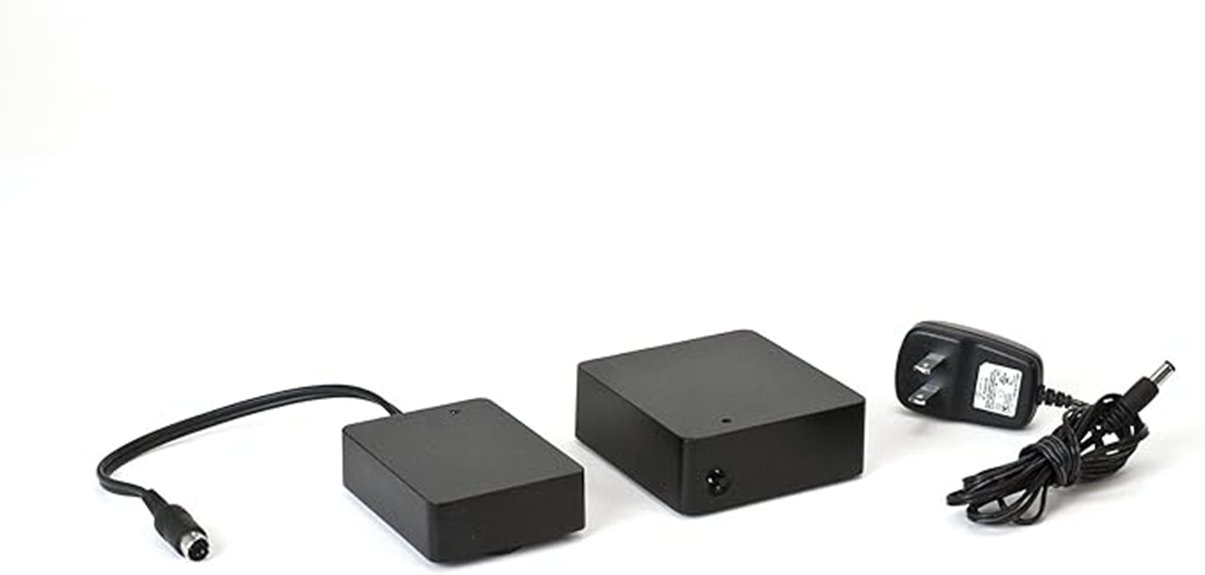
The Klipsch WA-2 Wireless Subwoofer Kit is an ideal choice for anyone looking to reduce cable clutter while expanding their bass with minimal effort. It’s designed exclusively for Klipsch-branded subwoofers with WA-2 ports, including models from Jamo, Energy, and Mirage. The kit includes a transmitter and receiver that connect wirelessly, supporting up to four units for broader coverage. Setup is simple—just plug in and pair—while the app allows for easy control. However, it relies on outdated 2.4 GHz Wi-Fi, which can cause interference. Overall, it’s a convenient solution for expanding bass, but reliability depends on your home Wi-Fi environment.
Best For: those seeking an easy, wireless bass expansion solution for compatible Klipsch subwoofers who are okay with potentially dealing with Wi-Fi interference issues.
Pros:
- Simplifies bass extension with a plug-and-play setup.
- Reduces cable clutter and allows flexible placement of subwoofers.
- Supports multiple units for expanded bass coverage in larger spaces.
Cons:
- Uses outdated 2.4 GHz wireless technology prone to interference.
- Compatibility limited to Klipsch-branded subwoofers with WA-2 ports.
- Occasional connection instability and standby functionality issues reported by users.
5.1 CH Surround Sound Bar with Dolby Audio

If you’re seeking an immersive home theater experience with minimal setup hassle, the CH Surround Sound Bar with Dolby Audio is an excellent choice. It offers 5.1-channel surround sound with Dolby Digital Plus, DSP technology, and 400W total power, creating room-filling virtualized audio with 360° immersion. The system includes wireless rear speakers and a 16-inch wireless subwoofer that delivers deep bass down to 50Hz, mimicking an IMAX experience. With multiple sound modes, Bluetooth 5.3 connectivity, and easy control via remote or manual buttons, it’s designed for straightforward setup and rich, crisp sound that enhances movies, music, and gaming effortlessly.
Best For: those seeking an easy-to-set-up, immersive home theater system with powerful surround sound and deep bass for movies, music, and gaming.
Pros:
- Easy plug-and-play setup with wireless rear speakers and subwoofer for minimal wiring
- Rich, clear 5.1 surround sound with Dolby Audio and deep bass down to 50Hz
- Multiple connectivity options including Bluetooth 5.3, HDMI ARC, optical, and more, compatible with various devices
Cons:
- Slight initial pairing issues that may require manual troubleshooting
- Non-waterproof design, limiting placement options in humid areas
- Plastic and wood construction may be less durable over time
ULTIMEA 7.1CH Surround Sound System with Dolby Atmos and Wireless Subwoofer
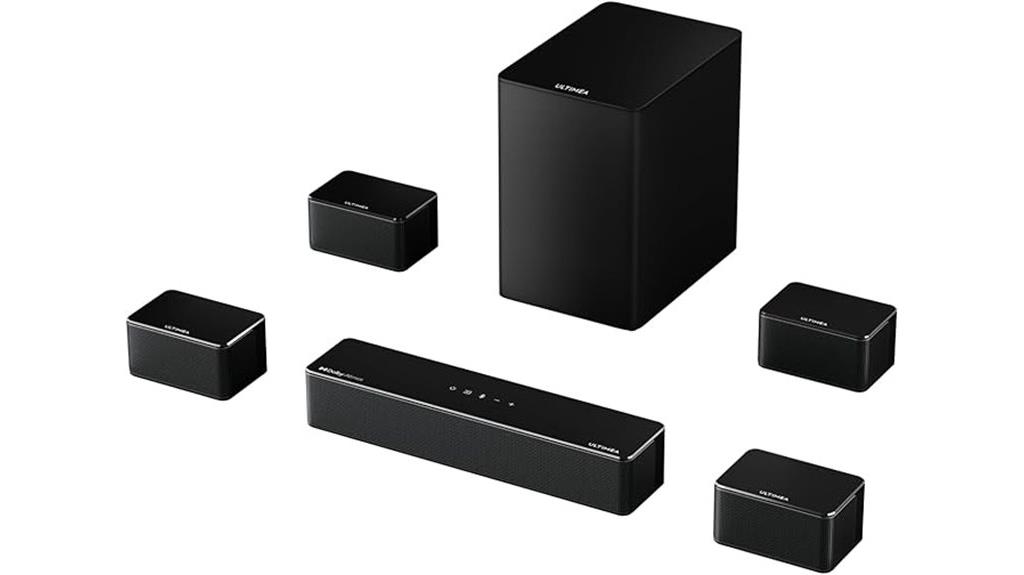
For anyone seeking an immersive home theater experience, the ULTIMEA 7.1CH Surround Sound System with Dolby Atmos and Wireless Subwoofer stands out as an excellent choice. This 7.1 system features a soundbar with Dolby Atmos support, a 6.5-inch wireless subwoofer, and four wired surround speakers, creating a wide soundstage. With 8 drivers, 320W peak power, and advanced tech like SurroundX and 360° Aural Spatial Tech, it delivers cinematic 3D audio. Versatile connectivity options—including HDMI eARC, optical, AUX, and Bluetooth—make setup easy. Users praise its deep bass, customizable sound, and straightforward installation, making it perfect for enhancing any home entertainment system.
Best For: home theater enthusiasts and gamers seeking immersive, high-quality surround sound with easy setup and versatile connectivity.
Pros:
- Delivers cinematic 3D audio with Dolby Atmos support for immersive experience
- Easy to set up with multiple connectivity options including HDMI eARC, optical, AUX, and Bluetooth
- Customizable sound with 121 EQ presets, multiple modes, and app control for personalized audio
Cons:
- Some users may find brand recognition limited compared to more established names
- Slightly larger dimensions may require adequate space for optimal placement
- Premium features may come at a higher price point during peak sales periods
Factors to Consider When Choosing a Wireless Subwoofer System
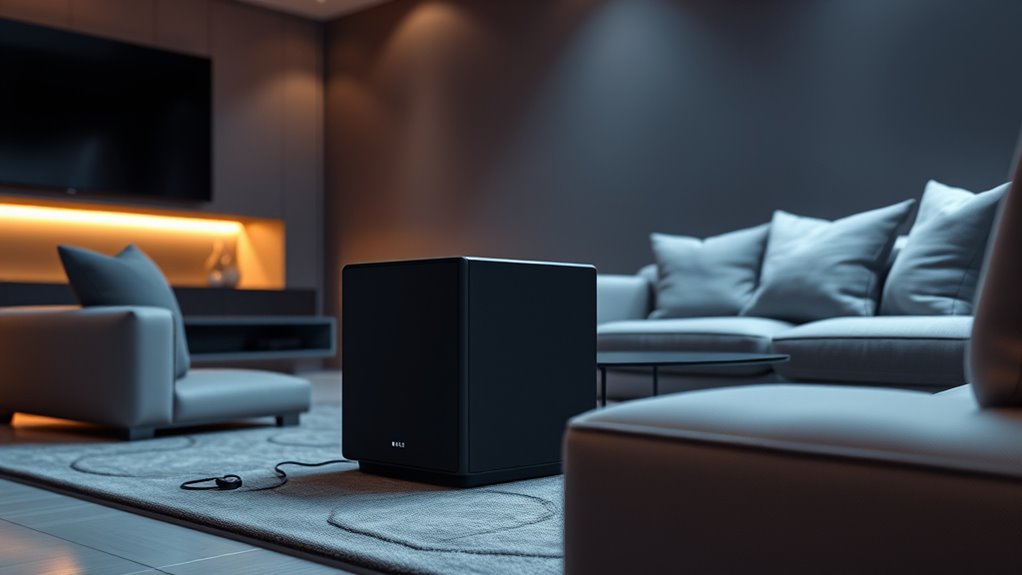
When selecting a wireless subwoofer system, I focus on compatibility with my devices, ensuring everything works seamlessly. I also consider the wireless range, power, and connectivity options to match my room size and setup needs. Finally, I look for sound quality features and how easy it is to set up, so I get the best experience without hassle.
Compatibility With Devices
Choosing a wireless subwoofer system that seamlessly integrates with your devices requires careful attention to compatibility factors. First, verify the system supports the same connectivity protocols as your main audio device, whether Bluetooth, Wi-Fi, or proprietary standards. Next, confirm that it works with your device’s input options like HDMI ARC, optical, AUX, or USB to guarantee smooth integration. It’s also important to confirm compatibility with your device’s operating system or app ecosystem for remote control and sound customization. Additionally, check that the subwoofer can connect without interference from other wireless networks or devices in your environment. Finally, review the supported audio formats—such as Dolby Atmos, DTS:X, or PCM—to ensure you get ideal sound performance from your setup.
Wireless Range Limits
Wireless range is a key consideration because even the most compatible subwoofer won’t perform well if it can’t maintain a stable connection throughout your room. Most wireless subwoofers have a range of 10 to 50 meters, depending on the technology. Older systems using 2.4 GHz frequencies often face interference from Wi-Fi networks and other electronics, reducing effective distance. Newer models with Bluetooth 5.4 or 5.3 can reach up to 15 meters with better stability and less interference. Physical obstacles like walls, furniture, and doors also weaken signals, lowering range further. Environmental factors, device placement, and nearby wireless signals can impact performance. It’s crucial to take into account these range limits to ensure your subwoofer stays connected and delivers deep, powerful bass without interruptions.
Power and Connectivity
Selecting the right wireless subwoofer involves more than just compatibility; you need to guarantee it has the appropriate technology, power output, and connectivity options to suit your setup. Make sure it supports stable wireless tech like 2.4 GHz or 5 GHz Wi-Fi to minimize interference. Check the subwoofer’s power output—measured in watts—to ensure it can produce the bass volume and depth you desire. Consider its maximum wireless range, typically 10-50 meters, so you can place it properly without losing signal. Look for multiple connectivity options like Bluetooth, Wi-Fi, or proprietary protocols to seamlessly integrate with your existing system. Also, verify the power supply requirements to assure reliable operation without needing extra adapters or power sources.
Sound Quality Features
When evaluating the sound quality of a wireless subwoofer system, focusing on its ability to produce deep, impactful bass that enhances your overall listening experience is essential. Look for systems with a frequency response below 50Hz, which ensures immersive low-end effects. Technologies like BassMX or high-excursion drivers improve bass clarity and richness, making the sound more dynamic. Wireless connection stability is critical; interference or lag can compromise audio fidelity and the surround sound experience. Using lossless audio transmission methods, such as HDMI eARC or advanced Bluetooth codecs, helps preserve sound quality from source to subwoofer. A well-designed subwoofer maintains balanced, distortion-free sound even at high volumes, delivering clarity across all bass frequencies for a truly powerful listening experience.
Ease of Setup
Choosing a wireless subwoofer system that’s easy to set up can save you time and frustration. Look for models with quick pairing processes, ideally with automatic recognition and minimal steps, so you’re not stuck troubleshooting. Clear, detailed setup instructions or user guides are essential, especially if you’re not tech-savvy, simplifying installation. Compatibility with your existing audio equipment and seamless integration with your main system ensure a hassle-free experience. Long-range wireless technology, like Bluetooth 5.4 or Wi-Fi, helps maintain a stable connection, reducing re-pairing or dropouts. Additionally, minimal wiring and flexible placement options make setup faster and cleaner, avoiding clutter and extensive cable management. Overall, a straightforward setup process lets you enjoy powerful bass sooner, without unnecessary complications.
Interference Risks
While ease of setup makes installing a wireless subwoofer simple, interference risks can still undermine your listening experience. Devices operating on the 2.4 GHz band, like Wi-Fi, Bluetooth, and household electronics, can cause dropouts, crackling, or lag. Cordless phones, microwave ovens, and baby monitors are additional sources that may disrupt the connection. To minimize these issues, choosing systems that operate on the 5.8 GHz band or use advanced wireless technologies can help reduce interference. Proper placement away from potential interference sources also makes a difference. Additionally, systems with adaptive frequency hopping can automatically switch channels for a more stable connection. Being aware of these factors ensures you select a wireless subwoofer that maintains reliable, high-quality bass without interruptions.
Price and Warranty
Price and warranty are crucial factors to take into account because they directly impact your long-term satisfaction and value. Wireless subwoofers range from about $100 for budget options to over $500 for premium models. Higher-priced systems often come with longer warranties, usually between one and three years, which shows greater confidence from manufacturers in their durability. Some budget models might have limited warranty coverage or require extra purchases for extended protection. Considering warranty terms helps you avoid costly repairs or replacements later on. It’s worth investing in a system with a solid warranty, especially if you plan to use it regularly. Balancing price with warranty coverage ensures you get a reliable product that offers good value over its lifespan.
Frequently Asked Questions
How Does a Wireless Subwoofer Improve Overall Sound Quality?
A wireless subwoofer improves overall sound quality by providing deep, powerful bass without the clutter of wires, allowing for flexible placement. I find that it delivers richer audio, enhances movie and music experiences, and creates a more immersive environment. Plus, I can easily position it for best sound, which boosts clarity and depth. Overall, a wireless subwoofer makes my setup cleaner and my sound more dynamic and engaging.
What Is the Typical Range for a Wireless Subwoofer Connection?
Wireless wonder? Typically, a wireless subwoofer’s connection range spans about 30 to 50 feet, depending on the system and obstacles like walls or furniture. I’ve found that open spaces enhance the distance, ensuring deep bass flows freely without interruption. Keep in mind, interference from other devices can impact this range, so placing your subwoofer wisely is key to maintaining consistent, powerful sound throughout your space.
Can Wireless Subwoofers Be Integrated With Existing Sound Systems?
Yes, wireless subwoofers can definitely be integrated with existing sound systems. I’ve done it myself, and it’s usually straightforward—just connect the subwoofer to your receiver or soundbar via Bluetooth or a dedicated wireless connection. Most modern systems are designed for compatibility, so you don’t need to worry about complicated setups. Just make certain your equipment supports wireless subwoofers, and you’ll enjoy deep, powerful bass in no time.
How Do I Troubleshoot Connectivity Issues With Wireless Subwoofers?
Ever wonder why your wireless subwoofer keeps disconnecting? I start by checking the Bluetooth or Wi-Fi connection, ensuring it’s within range and free of interference. Then, I restart both the subwoofer and the receiver, update firmware if available, and confirm they’re on the same network. Sometimes, simply re-pairing the devices solves the problem. Have patience—most issues are fixable with a few quick steps.
What Are the Energy Consumption Differences Between Wired and Wireless Subwoofers?
Wireless subwoofers generally consume more energy than wired ones because they constantly transmit data and require power for their wireless functions. Wired subwoofers draw power directly through their cables, making them more energy-efficient. If you’re trying to save on energy, a wired model might be better, but if convenience and cleaner setup matter more, wireless systems are worth the extra power use. I always weigh these factors before choosing.
Conclusion
Choosing the right wireless subwoofer system is like finding the perfect seasoning for a dish—small details make a huge difference. With options ranging from immersive Dolby Atmos setups to sleek Bluetooth bars, there’s something for everyone. Consider your space, budget, and sound preferences. When you find that ideal system, you’ll feel the deep, powerful bass like a thunderclap, transforming your home into a cinematic sanctuary. Happy listening!









